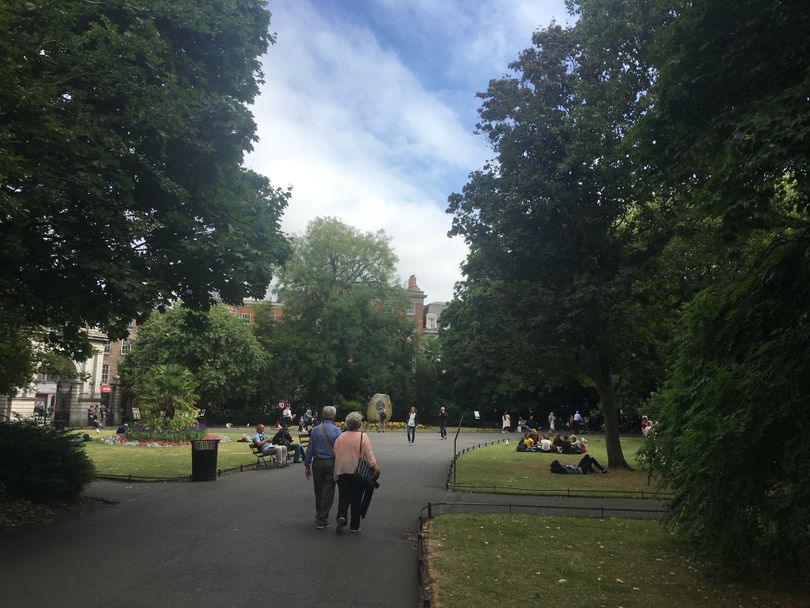When traveling, finding time to relax is key

You may not know the name Aubrey Lee White. But if you’re a fan of Spokane’s many urban parks, you should know that he is largely responsible for them.
White was the first president of the Spokane Board of Park Commissioners, a group that was instituted in 1907. White held the position for the next 15 years, and in that time he oversaw the purchase of thousands of acres of open land.
I take a daily walk with my friend Jim through one of those open spaces, Manito Park. Set on the South Hill with an entrance at 17th and Grand Boulevard, the park dates back to 1886 and was originally called Montrose Park by the area’s then owner, Francis Cook.
By whatever name, though, the place is a Spokane treasure. And shortly after the turn of the century, when the acreage was donated to the city, residents were able to enjoy it by riding a trolley line from downtown to visit the park’s many attractions. Among them were Duncan Garden (which still exists) and an 80-acre zoo (which does not).
Walking around the park the other day got me to thinking about how often, when traveling abroad, my wife – Mary Pat Treuthart – and I look for parks just to spend time in. Museum-going tops our typical lists of things to do in a foreign city, since all have cultural sites that are both entertaining as well as educational.
But parks, at least the ones we seek out, are a great way to relax, something that I in particular need to do when away from home. It also gives us a chance to see life as the locals live it. That’s true whether we’re talking about Chapultepec Park in Mexico City, the Buenos Aires Botanical Garden (and the hundreds of cats that prowl around it) or Florence’s Boboli Gardens. Or any number of others.
Which brings me to the trip we took to Ireland in the summer of 2018. We’d rented an Airbnb, which we shared with Mary Pat’s sister and her husband. And we ended up doing all the stuff that tourists tend to do.
So, yes, we visited Trinity College, site of the hallowed Book of Kells, and we were suitably impressed by the atmospheric Long Room Library, which houses some 200,000 books. We toured Dublin Castle, which dates back to the 13th century and feels more like a giant estate than something boasting classic turrets and towers.
As my wife is a lawyer, who teaches Criminal Procedure among other subjects to her Gonzaga University School of Law students, we had to take in Kilmainham Gaol, where several of the leaders of the 1916 Easter Uprising were held – 14 of whom were executed. And I insisted that we visit Glasnevin Cemetery, where a number of Ireland’s foremost poets, politicians and social activists – including Michael Collins – are buried.
Since this was my first time in Ireland, I insisted, too, that we visit Northern Ireland as well. And so we took the train north and spent a couple of days in Belfast, a city that – though The Troubles ended in 1998 with the Good Friday Agreement – still bears the scars of the sectarian struggle. But more on that another time.
For now, let’s get back to parks. Remember that I wrote about the value of parks, especially when you’re far from home and traveling through a foreign culture? Well, Condé Nast Traveler magazine claims that “Dublin’s well-manicured city parks provide peaceful escapes in the midst of busy city streets and sidewalks.”
I couldn’t agree more. And one day one of the most popular of those parks, St. Stephen’s Green, provided us with just the respite that we needed.
A little history here: The idea for this 22-acre green space dates back to 1663 when 27 acres were set aside as part of a housing development. Over the centuries the park’s popularity waxed and waned, depending on whether anyone – city governors or wealthy patrons – was interested in keeping it up.
In the early 1700s the northern perimeter of the park became the site of fashionable promenade for Dublin’s elite. But by the 19th century the park itself had fallen on hard times and become a private space. Access was limited to those with enough money to rent keys to the gates, which were kept locked. In other words, it was off-limits to the poor.
That all changed when Sir Arthur Edward Guinness, aka Lord Ardilaun, purchased the park. A great-grandson of the founder of the Guinness brewery, he oversaw the park’s landscaping and in 1880 gifted it back to the city. A statue of the man was erected in 1892, and it still stands on the park’s west side.
But that’s only part of the park’s history. It was seized by rebels during the 1916 Rising, with the result that bullet holes can be seen in the Fusilliers’ Arch that sits at the park’s northwest entrance. Today, however, its features include an ornamental lake, 15 commemorative sculptures and a children’s playground.
The Condé Nast Traveler article suggests watching the swans frolic in the lake (they call it a pond) and picnicking in Merrion Square “on a Thursday at lunchtime for the local food stalls.”
“And for real peace and quiet,” the magazine advises, “visit the Iveagh Gardens, where you might be the only non-local.”
We missed the picnic, though we did spend time in Merrion Square watching people take pictures on and around the Oscar Wilde Memorial Sculpture, which was designed by the English artist Danny Osborne and unveiled in 1997.
What we also did was walk slowly through the park. We found an empty bench. We sat for some time, watching the people – both Dubliners and tourists like us.
And as we have done so many times in Spokane parks, especially at Manito’s Mirror Pond, we did something else.
We relaxed.
